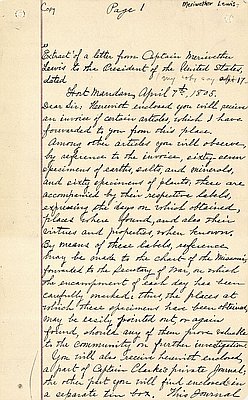Captain Meriwether Lewis carried this branding iron during the Corps of Discovery’s 1804-1806 exploration of western North America. The details of this artifact’s manufacture are lost in the mists of time, but historians have speculated that it might have been produced in 1804 at the armory at Harpers Ferry, Virginia, or perhaps by Private John Shields, a member of the Corps known for his iron-working skills. Lewis probably traded the iron in the spring of 1806 near The Dalles. In the 1890s, Hood River resident Linnaeus Winans found the iron on the north shore of the Columbia River near Memaloose Island. Winans gave the unique artifact to Philip L. Jackson, publisher of the Oregon Journal, who in turn donated it to the Oregon Historical Society in 1941.
Too large for branding livestock, such irons were usually used to mark wooden packing crates, barrels, and leather bags. Lewis’s iron was also used to mark trees as the Corps slowly made its way across the continent. In some cases, tree blazes functioned as property markers. For example, when Expedition members stashed a pirogue on an island near the mouth of the Marias River on June 10, 1805, William Clark noted in his journal that Lewis “branded several trees to prevent the Indians injureing her.” In addition to the tree blazes, Expedition members carved their names into rocks and cliff faces on more than a dozen occasions, leaving a trail of what some historians have termed “graffiti” behind them.
The blazes and carvings left by the Corps of Discovery went beyond simple graffiti, though. Other explorers had used similar inscriptions as imperial claim markers. Tree blazes functioned in much the same way as the more traditional cross or national flag, that is, as symbols of an imperial state’s claim to an area under the Doctrine of Discovery, a European legal theory which declared that the first European nation to “discover” a previously unexplored area occupied by non-Christians had the right to colonize it. This doctrine played an important role in justifying American claims to the Oregon Country.
Further Reading:
Saindon, Bob. “They Left Their Mark: Tracing the Obscure Graffiti of the Lewis and Clark Expedition.” We Proceeded On 13:3, 1987: 10-19, 22-23.
Graves, Bill. “Branding Oregon.” Oregonian, January 5, 2004.
Written by Cain Allen, © Oregon Historical Society, 2004.



